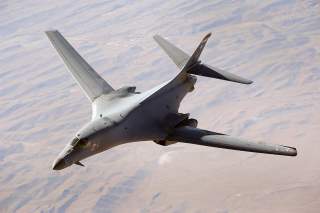A B-1 Bomber Fired a New Missile That Could Sink Russia or China's Navy
Another big step for the LRASM.
America’s future anti-ship missile has completed another successful test.
The successful test of the Long-Range Anti-Ship Missile (LRASM) were announced on May 23 by Lockheed Martin, the missile’s producer. “In the event over the Sea Range at Point Mugu, California,” Lockheed said in a press release, “a U.S. Air Force B-1B from Dyess Air Force Base, Texas, released the pair of LRASMs. The missiles navigated through all planned waypoints, transitioned to mid-course guidance and flew toward the moving maritime target using inputs from the onboard sensors. The missiles then positively identified the intended target and impacted successfully.”
This was the second time that Lockheed used two LRASM missiles against a single, moving ship. “The success of this second dual-LRASM test event speaks volumes,” David Helsel, the LRASM program director at Lockheed said in the press release. It was the seventh consecutive successful test of the LRASM, the most recent one being in March of this year. The LRASM was first tested against a moving target back in 2013.
LRASM is a DARPA and U.S. Navy-funded program meant to provide the U.S. Navy and Air Force with an offensive anti-surface weapon (OASuW) to counter the growing threats from highly-capable adversaries like Russia and China. The program was begun under DARPA in 2009 and leverages existing technology from the Joint Air-to-Surface Standoff Missile Extended Range (JASSM-ER) program. Its development was fast tracked under the Pentagon’s Better Buying Power 3.0 program, with the expectation that it would serve as a stopgap solution to compensate for the Navy’s aging Harpoon anti-ship missiles.
Recommended: A New Report Reveals Why There Won't Be Any 'New' F-22 Raptors
Recommended: How an ‘Old’ F-15 Might Kill Russia’s New Stealth Fighter
Recommended: How China Plans to Win a War Against the U.S. Navy
LRASM carries a one-thousand-pound penetrator and blast-fragmentation warhead. Although the JASSM-ER had a range of five hundred nautical miles, DARPA has suggested that the LRASM’s range is a little over two hundred nautical miles (nmi). Still, this range is significantly greater than the Harpoon ASM, which the U.S. Navy has merely labeled as “in excess” of sixty-seven nmi range (some variants can extend as far as 130 nmi). This has left the U.S. Navy dangerously outgunned in encounters on the sea against capable adversaries like China and Russia. Russia’s Club-N anti-ship missile, for instance, has a reported range of around 161 nmi. Beijing’s YJ-12 has a range of 215 nmi, meaning it should be roughly equal to LRASM.
LRASM is also designed to provide the U.S. Navy and Air Force with a precision-guided long-range standoff capability that can survive in aggressive electronic-warfare environments. To achieve this, it uses onboard sensors and a semiautonomous guidance system to reduce its dependence on intelligence, surveillance, and reconnaissance (ISR) platforms, network links and GPS navigation. It also employs “innovative terminal survivability approaches and precision lethality” to avoid advanced enemy countermeasures while still reaching its intended target. As Flight Global points out, these onboard sensors are not only useful for reducing its reliance on outside guidance systems. In addition, they help the LRASM “detect and destroy specific targets within groups of ships using its sensors, encrypted communications and a digital anti-jamming GPS.”
In July of last year, Lockheed Martin received the first production contract for the air-launched variant of LRASM. That $86.5 million contract was for twenty-three missiles as well as engineering support. Mike Fleming, David Helsel’s predecessor as the LRASM director at Lockheed, said at the time that “this first production lot of LRASM brings a new level of capability to both the U.S. Air Force and the Navy. LRASM enables our warfighters to prosecute even the most advanced enemy ships.”
That wasn’t the only milestone of the LRASM that took place in July 2017. That same month, Lockheed conducted its first test of a modified LRASM from a shipborne topside canister. launcher. Previously, sea-launched LRASMs had been test fired from MK-41 Vertical Launch Systems that are on board American cruisers and destroyers. But the use of a surface canister would allow the Navy to equip littoral combat ships and frigates with the missile as well.
Although the accelerated LRASM program will initially produce missiles for aircraft, the U.S. Navy eventually wants to put them on ships. The reason is simple: quantity. As Sydney Freedberg explained at Breaking Defense: “At the very maximum, with nothing held back for defense (which would be tactical insanity), an entire carrier air wing of 44 fighters could only carry 88 LRASMs, while a single Arleigh Burke destroyer could carry 96.”
The ship-based versions are for the more distant future. The LRASMs are expected to debut on B-1B bombers sometime this year before being placed on F/A-18 Hornets next year. It is unclear when U.S. Navy ships will actually be fitted with the LRASM.
Zachary Keck (@ZacharyKeck) is a former managing editor of the National Interest.
Image: Wikimedia Commons

